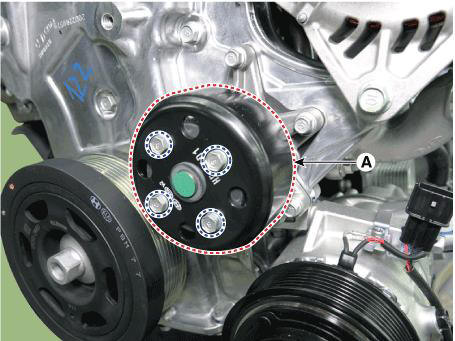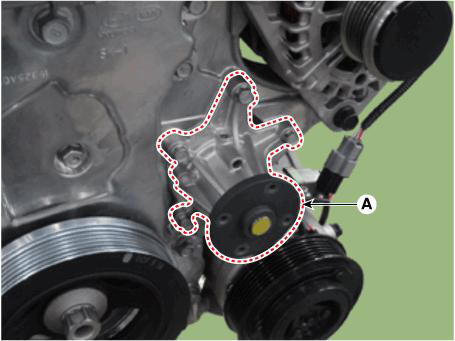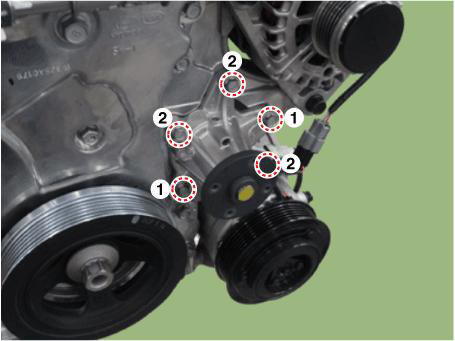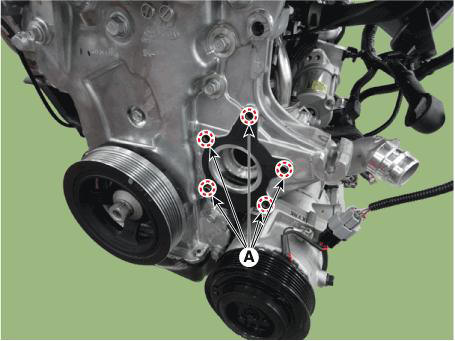Hyundai Tucson: Troubleshooting
Trouble Symptom
Coolant leakage
- From the bleed hole of the water pump
- From gaskets or bolts
- From outer surface of water pump
Probable Cause
Visually check
- Check leaks after about ten-minute warming up.
- If coolant still leaks, replace a water pump.
- If leakage stops, reuse the water pump (Do not replace the pump with a new one).
WARNING
Be careful not to misrepair because evaporite sediment caused by tiny vapor evaporation or a little coolant evaporation evidence can happen even when the water pump operates normal.
- Get rid of sediment in the air hole, and recheck there is leakage or not.
- Check the tightening of the water pump mounting bolts.
- Retighten the mounting bolts.
- Check damage of gaskets or inflow of dust.
- Replace the gasket and clean dust off.
- Check the material or any cracks of the water pump.
- Poor material. If any crack found, replace the water pump.
Trouble Symptom
Noise
- From bearings
- From mechanical seals
- Impeller interference
Probable Cause
Inspection with a stethoscope
After starting the engine, check noise with a stethoscope.
- If there is no noise, reuse the water pump (do not replace it).
- If there is any noise from the water pump, remove the drive belt and recheck.
Inspection after removing a drive belt
After removing a water pump and a drive belt, check noise again
- If there is noise, reuse the water pump. (Check other drive line parts)
- If there is no noise, replace the water pump with a new one.
Inspection after removing a water pump
Check water pump body and impeller interference.
- If there is any interference between them, replace the water pump with a new one.
Trouble Symptom
Overheating
- Damaged impeller
- Loosened impeller
Loosened impeller
- Corroded impeller insert
- Replace the water pump if it is separated by corrosion between impellers and inserts
- Replace the water pump if there is a crack in the PL impeller.
- Check engine coolant.
- Poor coolant quality / Maintenance check
- Impeller seperated from the shaft
- Replace the water pump.
Overheat warning lamp
Excessive Coolant Temperature
Obstruction of radiator by foreign matter Check the front of the condenser/radiator inside the bumper for contamination by debris.
- Clean the radiator
Removal
- Remove the engine room under cover.
(Refer to Engine and Transaxle Assembly - "Engine Room Under Cover")
- Drain the coolant
(Refer to Cooling System - "Coolant")
- Remove the drive belt.
(Refer to Drive Belt System - "Drive Belt")
- Remove the water pump pulley (A).
Tightening torque : 9.8 - 11.8 N.m (1.0 - 1.2 kgf.m, 7.2 - 8.7 lb-ft)

- Remove the water pump (A) with a gasket.
Tightening torque : 11.8 - 13.7 N.m (1.2 - 1.4 kgf.m, 8.7 - 10.1 lb-ft)

- Install in the reverse order of removal.
WARNING
- Always use new water pump gasket.
- Check the specifications of the water pump instaling bolts. (Make sure that a solid sealant is applied to the thread of the bolt.)
- Always use new water pump bolts.
- Remove the sealant residue inside the bolt tap hole.
- When installing the water pump, tighten the bolts in the order shown in the figure below.

- Before installing the water pump, remove the hardened sealant, foreign
matters, oil, dust, water, etc.
off the inside hole (A) where the bolt is installed.

- Fill with engine coolant.
(Refer to Cooling System - "Coolant")
WARNING
The coolant must be injected according to the integrated thermal management module (ITM) coolant filling method.
- Start engine and check for leaks.
Description
The AAF (Active Air Flap) is located between radiator grille and radiator.The AAF controls the motor properly and then the air flaps adjust air flow from the radiator grille.
During high speed driving, it will reduce the air resistance by closing the air flaps. This improves the fuel efficiency and enhances the driving stability. If the engine is overheated, the system will open the air flaps to drop the temperature.During the A/C operation, the system will open the air flaps to maintain the refrigerant pressure. The system will close the air flaps to warm up the engine rapidly during cold start.
READ NEXT:
 Active Air Flap(AAF)
Active Air Flap(AAF)
Remove the front bumper.
(Refer to Body (Interior and Exterior) - "Front Bumper Cover")
Disconnect the active air flap connector (A).
RH
LH
Remove the active air flap (A) after loosening the mounting screws.
RH
 Active Air Flap (AAF) Actuator
Active Air Flap (AAF) Actuator
Remove the front bumper.
(Refer to Body (Interior and Exterior) - "Front Bumper Cover")
Disconnect the active air flap connector (A).
RH
LH
Remove the active air flap actuator (A) after loosening the mounting
screw
SEE MORE:
 Rear Suspension System - Removal
Rear Suspension System - Removal
WARNING
When lifting a vehicle using a lift, be careful not to damage the
lower parts of the vehicle (floor under
cover, fuel filter, fuel tank, canister).
(Refer to General Information - "Lift Point")
Loosen the rear wheel nuts
 Front Radar System - Description and operation
Front Radar System - Description and operation
WARNING
The System may be limited when
The radar sensor or camera is blocked with a foreign object or
debris.
The camera lens is contaminated due to tinted filmed or coated
windshield, damaged glass, or smck of foreign matter
(sticker,
Information
- Home
- Hyundai Tucson - Fourth generation (NX4) - (2020-2023) - Owner's Manual
- Hyundai Tucson - Fourth generation (NX4) - (2020-2023) - Workshop Manual